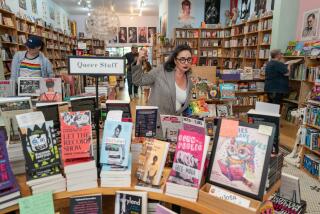Jewish Community Library may be bound for new location
Bina Weiss and her eight children have borrowed hundreds of books and videos from the Jewish Community Library, a little-known gem housed in the Wilshire Boulevard headquarters of the Jewish Federation of Greater Los Angeles.
“This is what my kids will read in a week,” said Weiss, 44, balancing a teetering stack of 25 books. “Whenever I need a book, this is the place I come.”
News that much of the library’s collection could relocate to the campus of the American Jewish University on Mulholland Drive in Bel-Air -- a 13.5-mile schlep over streets and freeway -- elicited a Yiddish expression of dismay.
“Oy!” Weiss said. “That means nobody will be able to go.”
The federation begs to differ. Its research shows that most of the region’s Jewish population long ago shifted to areas such as the San Fernando Valley, Conejo Valley and Simi Valley. For those patrons, federation officials figured, the Mulholland location would be more convenient than an office building on the busy Wilshire corridor near Beverly Hills.
“We believe the needs of the broader Los Angeles-area Jewish community are best served by relocating,” said John Fishel, president of the nonprofit Jewish federation. “The idea is not just to shuffle it out of this building but to put it in a place that’s accessible, where it could become more robust.”
The federation and the university said talks about the relocation were continuing.
Fishel emphasized that the federation would relocate only the library’s adult collection, now housed on the building’s third floor. (Patrons must be escorted there from the lobby.)
The Slavin Children’s Library would remain in its current spot on the first floor, across the lobby from the Zimmer Children’s Museum.
Weiss, for one, said that was a small consolation, given that her teenage sons usually frequent the adult library while she stays with her young daughters downstairs.
The library’s collection consists of about 30,000 items, written or created by Jewish authors and artists for a Jewish audience. It includes centuries-old books about Jewish law and values; Holocaust literature; kosher cookbooks; an inflatable 30-by-13-foot map of Israel; Jewish plays and music; and archival material about Jewish people, places and organizations. Many books are in Hebrew, Yiddish and Russian.
The collection is mostly G-rated -- the “Funny Girl” DVD is about as racy as it gets.
Abigail Yasgur describes the relocation plan as a “historic misstep.” Yasgur, a librarian who directed the Jewish Community Library for 12 years, resigned recently in protest.
“The library needs to be on the way -- from school to home, from work to the market -- so that it can be integrated into people’s daily lives,” she said. “It doesn’t make sense to have it become a destination.” And that, she said, is what it would become if it moved to Mulholland.
Robert Wexler, president of the American Jewish University (formerly the University of Judaism), said his institution’s chief interest is to get “more people to be engaged with the Jewish book.” The university has a large Jewish adult education program that serves 13,000 participants each year -- a ready-made audience for the federation’s collection, Wexler said.
The university is raising money to more than double the size of its existing Ostrow Library, to more than 20,000 square feet. The expansion would absorb the federation’s resources. Plans call for creating a reading garden and outdoor areas where patrons can sit and talk.
Wexler said it wasn’t yet clear how much of the collection would be moved to the university, because the school might already have some of the same books in its own collection.
“Obviously, duplicates won’t” be moved, he said.
Fishel said the federation and the university were discussing how the collection would be maintained if moved. “It is clear to us that the AJU . . . is expecting us to continue funding,” he said. “So it would be ours as well.”
Still, the prospect worries Susan Dubin, president of the Assn. of Jewish Libraries, an international organization representing about 1,100 libraries.
“The mission of a community library is very different from a university library,” she said. “By combining the collections, we’re going to lose that community aspect.”
--
More to Read
Sign up for Essential California
The most important California stories and recommendations in your inbox every morning.
You may occasionally receive promotional content from the Los Angeles Times.











